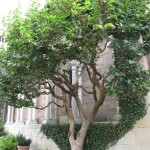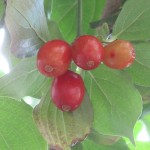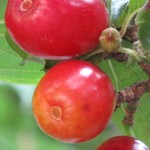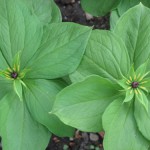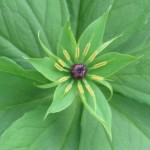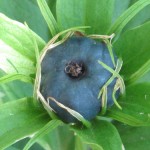Posts Tagged ‘Hortus Sanitatis’
Friday, April 5, 2013
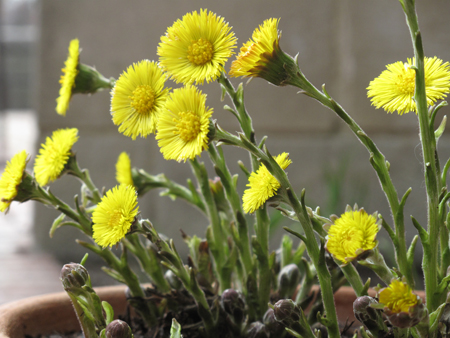
Coltsfoot blooming in a pot in Bonnefont garden. The scaly stems and bright yellow blossoms of this early-spring-blooming member of the daisy family emerge well before the foliage; the hoof-shaped leaves appear only after the flowers have set seed. This notoriously invasive Eurasian species is best grown in a container. Photograph by Carly Still
Tussilago farfara, known in the Middle Ages under the Latin names ungula caballina (”horse hoof”) and pes pulli (”foal’s foot”), is still called coltsfoot, ass’s foot, or bull’s foot in English, pas-de-poulain in French, pie d’asino in Italian, and hufflatich in German. These names all derive from the fancied resemblance of the young leaf to the foot of a quadruped. See an image of the plant in leaf. A slideshow of images of Tussilago farfara in all stages of growth is available at Arkive.org.
Read more »
Tags: Asteraceae, coltsfoot, Dioscorides, Hildegard of Bingen, Hortus Sanitatis, Pliny, tussilago
Posted in Gardening at The Cloisters, Medicinal Plants | Comments (4)
Friday, August 3, 2012
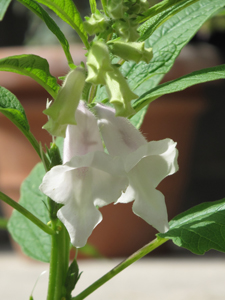
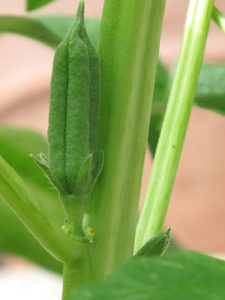
Sesame, also known as “benne,” is a tender, large-leaved, Asian annual grown here in Bonnefont garden. Sesame has been cultivated for some five thousand years and was known to many cultures in antiquity. Although the plant is somewhat rangy and coarse in habit, the tubular flower (above, left) is attractive. The immature green pods (above, right), which will split and spill out their seeds when ripe, contain one of the world’s oldest domesticated oilseeds. The seeds also have a long history of use as a seasoning.??Photographs by Carly Still.
A cultivated plant of fabulous antiquity, sesame (Sesamum indicum) is known as simsim in Arabic, susam in Turkish, sesam in German, s??same in French, sesamo in Italian, and sesame in Spanish. Called sesemt by the ancient Egyptians, it was also grown in Ethiopia in very early times. Sesame seeds were taken from West Africa to America by slave traders; the name “benne” derives from the West African benni. Sesame had long been grown in India and Persia, and was introduced to China by the end of the fifth century A.D. Read more »
Tags: De Materia Medica, Dioscorides, flax, hellebore, Herodotus, Hortus Sanitatis, John Ruskin, poppy, sesame, Sesamum indicum
Posted in Food and Beverage Plants, Medicinal Plants | Comments (0)
Thursday, April 5, 2012
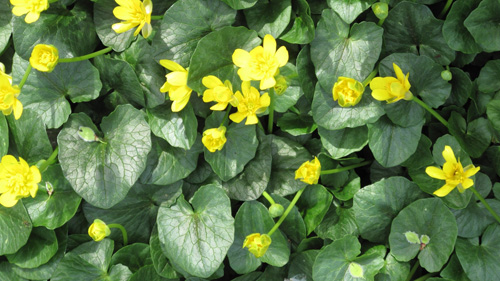
A colony of lesser celandine (Ranunculus ficaria) growing in the orchard below the south wall of Bonnefont garden.
The shining yellow flowers of lesser celandine star the grounds below Bonnefont garden in March and April, but the blossoms and the heart-shaped leaves of this spring ephemeral will disappear altogether by summer. The tuberous roots, which lie just beneath the surface of the soil, will remain dormant until the following spring. This invasive medieval species is not grown within the walls of The Cloisters, but has long been at home throughout the northeastern United States. (See the Ranunculus ficaria page of the Invasive Plant Atlas of New England website.)
Read more »
Tags: buttercup, celandine, Chelidonium majus, Hildegard of Bingen, Hortus Sanitatis, John Gerard, lesser celandine, poppy, Ranunculus ficaria, scrofula
Posted in Gardening at The Cloisters, Medicinal Plants | Comments (3)
Wednesday, October 12, 2011
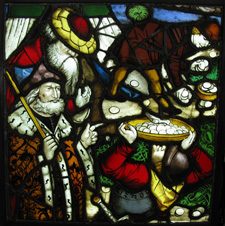
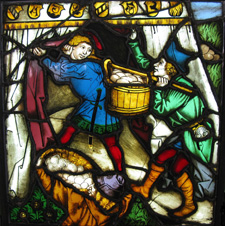
The marvelous food??depicted in these two panels of Late Gothic German stained glass may have been of vegetable origin. Left: Gathering Manna. Moses, holding the staff received from God on Mount Sinai, presides over the gathering of a miraculous fall of quail and manna from heaven. Right: Storing up Manna. Two men bear a large wooden tub of manna into a tent; a third man carries a great basketful in his arms.
The identification of Biblical plants has occupied investigators for centuries; the identity of manna is??one of??the most intriguing and most debated of ethnobotanical mysteries, although some interpreters have suggested that the substance is of insect rather than vegetable origin. Read more »
Tags: Albertus Magnus, algae, Avicenna, Bible, Circa Instans, Coccus manniparus, Exodus, Fraxinus ornus, Hortus Sanitatis, Lecanora esculenta, lichen, manna, Nostoc commune, Platearius, tamarisk, Tamarix mannifera
Posted in Food and Beverage Plants, Medicinal Plants, Plants in Medieval Art | Comments (1)
Thursday, September 8, 2011
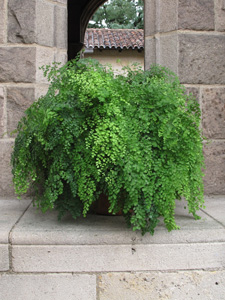
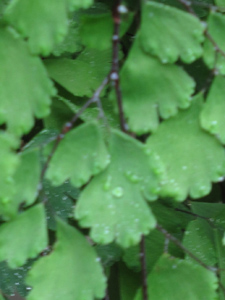
The lovely Venus maidenhair is not quite hardy for us at The Cloisters, and is grown in pots in the medieval gardens. The pinnules of this graceful fern, which flourishes in moist and rocky situations in many parts of the world, repel water.?? Photographs by Carly Still
The southern or Venus maidenhair (Adiantum capillis-veneris)??belongs to a large genus of ferns that includes two hundred species. The botanical name given to the genus Adiantum is from the Greek for “unwetted,” since any water falling on the foliage of these ferns beads up, leaving the leaf surfaces dry. This species was??already known by that name??in classical antiquity; the Roman natural historian Pliny marveled that a plant that grew in moist places exhibited such a marked antipathy to water. According to Pliny, the plant??was known to some as “beautiful hair” or “thick hair.”?? A decoction of the fern, made by??simmering it with celery seed in wine and oil, was used both to dye the hair and to prevent it??from falling out (Historia naturalis, Book XXII, 62???65). Read more »
Tags: Adiantum, baldness, Dioscorides, fern, Hortus Sanitatis, maidenhair, Maude Grieve, pinnule, Pliny, Rufinus, Salerno, stipe, Venus
Posted in Gardening at The Cloisters, Medicinal Plants | Comments (5)
Friday, April 1, 2011
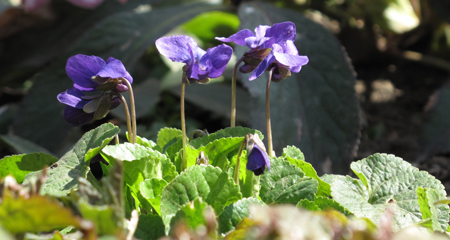
The sweet-smelling, short-stemmed garden violet (Viola odorata) blooms from late March into April. Prized in medieval pleasure gardens for its color and scent, this violet was also at home in kitchen and physic gardens. Photograph by Corey Eilhardt
Native to woodland margins and damp and shady places throughout Europe, the early blooming Viola odorata was prized for its fragrance as well as its rich purple color. The sweet violet is included in Albertus Magnus’ list of desirable flowers for the pleasure garden, along with the lily and the rose. These three flowers are often linked symbolically as well as horticulturally in medieval sources, as flowers of Paradise and as emblems of the Virgin???the low-growing but beautiful and sweet-scented violet was equated with Mary’s humility. Read more »
Tags: Albertus Magnus, Gode cookery, Herbarius Latinus, Hildegard von Bingen, Hortus Sanitatis, Physica, Tacuinum Sanitatis, Viola odorata, violet
Posted in Fragrant Plants, Gardening at The Cloisters | Comments (1)
Friday, September 24, 2010
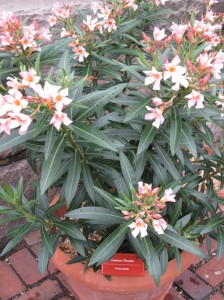
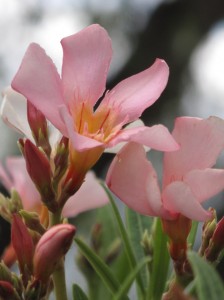
Above, from left to right: Nerium oleander, a tender evergreen shrub native to the Mediterranean, is grown in pots at The Cloisters and brought indoors for the winter. Oleander belongs to the Apocynaceae, or Dogbane family, which contains many poisonous species. The five petals of the oleander flower are fused at the base and form a tube; the form of the flower is typical of this botanical family. Photographs by Corey Eilhardt.
Nerion, which some call Rododaphne, some Rhododendron . . . grows in enclosed greens and sea-bordering places & in places near rivers. But ye flower and the leaves have a power destructive of dogs & of Asses & of Mules & and of most four-footed living creatures, but a preserving one of men, being drank with wine against the bitings of venemous beasts & ye more if you mixed it with Rue, but ye more weak sort of living creature, as goats & sheep, die, if they drink ye maceration of them.
???Dioscorides, De Materia Medica, Book IV, 82
Read more »
Tags: Apocynaceae, Dioscorides, Dogbane, Hortus Sanitatis, Nerium oleander
Posted in Gardening at The Cloisters, Medicinal Plants | Comments (2)
Friday, August 13, 2010
Above, from left to right: A mature cornelian cherry (Cornus mas) established against the east wall of Bonnefont garden; the foliage of Cornus mas is typical of the dogwood family to which it belongs; the tart red fruits, known as cornels, don’t ripen fully until after they fall from the tree in late July and early August. Photographs by Corey Eilhardt.
A native of dry, deciduous forests in central and southern Europe and western Asia, the cornelian cherry is a relative of our own flowering dogwood, Cornus florida. The fruit of the cornelian cherry is classified botanically as a drupe, as is the fruit of the true cherry, Prunus cerasus, but the two plants are in no way related. Although the fruits are unfamiliar to Americans, Cornus mas is very widely grown in this country as a small ornamental tree or as a multi-stemmed shrub, prized for the host of little yellow blossoms that veil the naked stems and branches in early March. Read more »
Tags: acorn, Alan Davidson, cherry, Circe, cornel, cornelian, Cornus florida, cornus mas, Dioscorides, drupe, Giacomo Castelvetro, Hildegard von Bingen, Homer, Hortus Sanitatis, kizilchik, Lee Reich, medlar, Prunus cerasus, quince
Posted in Food and Beverage Plants, Medicinal Plants | Comments (5)
Wednesday, June 23, 2010
Above, from left to right: Herb paris (Paris quadrifolia) flourishing in the dappled shade of a quince tree in April (although typically four-leaved, five- and six-leaved forms of herb paris like these are not uncommon); a detail of the narrow-petaled, star-like green flower with golden stamens; detail of the single black fruit, ripening in late June. Photographs by Corey Eilhardt.
Herbe Paris riseth up with one small tender stalke two hands high; at the very top come forth foure leaves directly set one against another in the manner of a Burgundian Crosse or True-love knot: for which cause among the Antients it has been called Herbe True-love.
???John Gerard, the Grete Herbal, or Generall Historie of Plants
Trew-loue among men is that most is of lette,
In hates, in hodes, in porses, is sette.
Trewe-loue in herbers spryngeth in May.
Bot trew-loue of herte went is away.
???Popular Middle English rhyme.
The leaves of herb paris suggested both the the cross of Christ and the true-love knot to the medieval mind, and both these resemblances were exploited allegorically. The popular Middle English rhyme quoted above alludes to the custom of placing the spring-blooming herb paris in hats, hoods, or purses as a charm for luck in love, while stressing how quickly such love is lost. Read more »
Tags: arsenic, Fasciculus Morum, Geoffrey Grigson, Grieve, herb paris, Hortus Sanitatis, John Gerard, Juliet, medicine, mercury, pars, Pietro Mattioli, poison, quadrifolia, quatrefoil of love, Romeo, Susanna Greer Fein, true love, Venus
Posted in Magical Plants, Medicinal Plants | Comments (0)
Friday, June 4, 2010
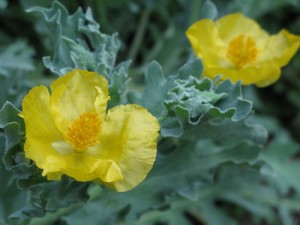
Horned poppy (Glaucium flavum) flowering in Bonnefont Garden in a sunny bed devoted to medicinal plants. Like other members of the poppy family, the horned poppy contains poisonous alkaloids.
The yellow horned poppy hath whitish leaves very much cut or jagged, somewhat like the leaves of garden Poppie, but rougher and more hairie. The stalks be long, round, and brittle. The floures be large and yellow, consisting of foure leaves; which being past, there come long huskes or cods, crooked like an horn or cornet, wherein is conteined small black seede. The roote is great, thicke, scalie, and rough, continuing long.
???John Gerard (1545???1612)
The Elizabethan herbalist John Gerard???s meticulous description of the plant which he names in Latin as Papaver cornutum flore luteo, “the horned poppy with the yellow flower,” was based on personal observation. He notes that it “groweth upon the sands and banks of the sea,” and lists the many places along the English coast where he found it growing. Read more »
Tags: alkaloid, Dioscorides, Eryngium maritimum, Geoffrey Grigson, Glaucium flavum, Hortus Sanitatis, John Gerard, poppy, sea holly, sea poppy
Posted in Medicinal Plants | Comments (1)












